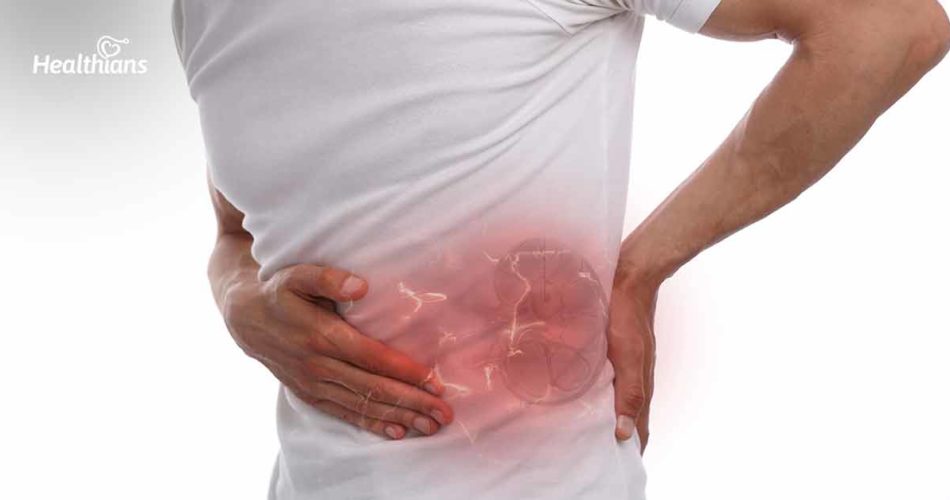Contributed by: Healthians Team
Did you know?
- Kidneys are bean-shaped organs about the size of a closed fist located under the ribs and above the waist (at the back)
- Approximately 180 litres of blood is filtered by the kidneys every day
- They manage the production of red blood cells and regulate blood pressure by releasing certain hormones
- Kidneys remove waste products from the body through urine
- The formation of kidney stones is more common in males than females
- Kidneys help promote bone health by producing an active form of vitamin D
- Kidney stones are one of the most common kidney ailments with about 12% of the total population in India estimated to have kidney stones
What are kidney stones?
Kidney stones are solid crystals that develop when dissolved minerals build up in the kidneys. The condition mainly occurs when a person has low fluid intake or exercises too much or too little. Obesity, excessive weight gain, weight loss surgery, foods with excessive salt or sugar, and a family history of this condition are some other common causes of kidney stones.
The size of a kidney stone can vary drastically. Though most kidney stones are about the size of a chickpea, they can also be as small as a grain of sand, or as big as the size of a golf ball. While small kidney stones are easily flushed out of the body with urine (they may cause a little pain), it is the bigger ones that can give rise to severe pain and require immediate medical attention as they can lead to other complications like urinary problems, kidney infections, or kidney failure.
In this article, you’ll get all the information you need to help you recognize kidney stones, their types and to understand what causes kidney stones. We’ll also discuss the risk factors associated with kidney stones, diagnosis, treatment, preventive measures and home remedies that can be employed to prevent the aggravation of the condition.
Symptoms of kidney stones
It is possible to have kidney stones and lack symptoms until the stones start to move or grow bigger. The commonly manifested symptoms include:
- Revolving lower back pain that starts as a dull ache and may come and go
- Pain in the groin and side of the abdomen
- Blood in the urine
- Vomiting and nausea
- Urinary tract infection (UTI)
- Frequent urge to urinate
If stones block the passage of urine, it may give rise to kidney infection and manifest symptoms which include:
- Fever and chills due to infection
- Weakness and fatigue
- Diarrhoea
- Foul-smelling cloudy urine
Types of kidney stones
Kidney stones are categorized into four major types, which include:
- Calcium stones: Stones that develop when the kidney retains excess calcium which is not used by the body and is neither flushed out. The retained calcium combines with other waste products in the kidney and gives rise to a solid crystal, known as calcium oxalate.
- Uric acid stones: The formation of these stones is a result of a lack of water in the body. Urine consists of uric acid, and when the body does not have enough water to dilute this acid, the urine becomes more acidic and gives rise to uric acid stones in the kidneys.
- Struvite stones: These stones contain magnesium and ammonia and form after a urinary tract infection (UTI).
- Cystine stones: This is a condition in which ‘cystine’- a substance present in the muscles builds up in the urine. It is rare and generally a hereditary condition.
Causes & risk factors of kidney stones
Kidney stones mainly occur due to dehydration. Some other risk factors include
- A family history of kidney stones
- Personal history of kidney stones
- A high protein and sodium diet with a sedentary lifestyle
- Obesity, diabetes, and high blood pressure are some complications that can give rise to kidney stones
- Pregnancy
- Recent digestive system surgery
- A health condition that affects the process of calcium absorption, such as inflammatory bowel disease (IBD) or chronic diarrhoea
Kidney stone diagnosis
Various tests can reveal the presence of kidney stones, such as:
- A physical examination to identify the area of pain
- Urinalysis can divulge the presence of blood or any infection through a small urine sample
- Image testing such as an X-ray, CT scan, or ultrasound. Image testing helps in identifying any sort of structural changes in the size of the stone.
Kidney stone treatment & surgery
The existence of stones in the kidney can cause severe pain and may even become a life-threatening condition by giving rise to complications such as kidney infection and kidney failure. Thus, it is mandatory to take preventive measures and seek medical attention upon experiencing the symptoms.
The existence of stones in the kidney can cause severe pain and may even become a life-threatening condition by giving rise to complications such as kidney infection and kidney failure. Thus, it is mandatory to take preventive measures and seek medical attention upon experiencing the symptoms.
The doctor may recommend treatment options depending upon the severity of the condition. These include:
- Shock wave lithotripsy (SWL): SWL is one of the most recommended kidney stone treatments in which ultrasound waves are used to shatter the stone so that it can easily pass through urine.
- Ureteroscopy: While treating kidney stones by using the ureteroscopy method, the doctors uses lasers that pass through a long thin tube from the urethra to the ureter to break the stones.
Preventive measures & home remedies
To manage kidney stones and prevent their worsening, a doctor may approve avoiding certain foods and recommend some home remedies. Here’s a list of them:
Foods to avoid
- Reduce salt and sugar intake
- Lower the protein intake, mainly through non-vegetarian foods
- Don’t consume aerated beverages
Some home remedies include
- Increase water intake
- Lemon juice
- Basil juice
- Apple cider vinegar
- Pomegranate juice
Note: Some over the counter medicines can also help manage the condition, but it is important to take into consideration that the medicines should be prescribed.
Final thoughts
Kidney stone is a serious complication and it should not be left untreated or ignored. If you experience the above-mentioned symptoms, we recommend you undergo an early diagnosis to ascertain the exact cause of pain and take steps to avoid any serious complications. By undertaking preventive measures and home remedies, you can manage the aggravation of the condition and may even be able to ease the symptoms.




